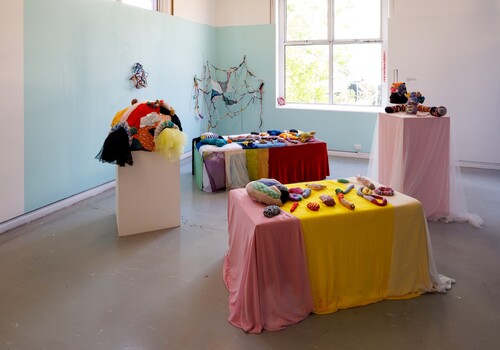Painting, Victorian College of the Arts
By Ella Howells
When Max Ernst transferred the texture of a grimy floor onto a paper substrate by rubbing back and forth with pigment, he borrowed the term “frottage” to describe it. This method of automatic art production invokes the metaphysical vigour of transmuting the dreamlike into the material and back again. It’s a revelatory practice woven throughout paintings at VCA this year.
Caesar Florence-Howard’s expansive paintings murmur calligraphic undulations. They unfurl like a lost language translated by a spirograph: hieroglyphics found beneath a boulder, unearthed then resuscitated with organic airiness. In Blue painting, superglue is applied in spiralised lines to raise their profile above the canvas’ surface, then oil pastel and acrylic are scumbled over as frottage, revealing the glyphs through contrast.

Anaïs Lesage Baker employs frottage through layers of textiles, pastel, crayon and acrylic in the varied hues of bruises. A large charcoal “A” on hessian is stretched over a frame like an anarcho-primitivist banner. She repeatedly scratches her name in naïve handwriting as tallied incantations on the plasticky slick of an AbEx canvas painting. For N painting, she dyed the canvas black, but the result is muddy and tiedye-esque, the texture of a brownstone building etched by pencil vandals that keeps getting buffed. Town features oil pastel scrawls above a charcoal abyss on raw canvas, with a thin layer of pocked muslin stretched over. She tells me it’s the same material as her Muji doona cover. I admire how it flattens subliminal chaos into blueness. It’s a bad dream consoled by Napi-San, gauze safely dressing the wound.

Similarly dreamlike, Clara Joyce arranges acrylic stain in blurred kaleidoscopic swarms across her canvases. Optical illusions abound: Quasi Painting Object is a welded vitrine magnetically inset with lenticular LCD screens refracting rainbow haloes, and Natural observers tests what the eye will recognise as human. Across the room, Evangela Lines-Morison converses with this idea in the hyperreal realm with matte precision, painting Elvis impersonators, vegetables and aerosols as though slightly warbled through an AI image simulator.


Freshly woken, I witness Chelsea Young’s frottaged Pride flag transfer painting SUCH IS LIFE and spirulina painting Goop’d slouch in the matrices of a gridded scaffold. It’s constructed from sharpened, charred wood using a cherry-picker to fill the prism of the sculpture shed’s slanted roof. Young’s installation counters corporatised Pride and Wellness through sexy Foucauldian incarceration. She relays a description of it as a “dyke torture chamber”, all cages and bars over stencilled pop-art icons. Spirulina powder from Goop’d dusts the floor (dry), while gesso-pasted layers on its verso recall street-side Pride posters drenched in rain (wet). Post-party, it’s a soggy decoupage, discarded ribbons whipping in the wind.

Frottage also describes libidinal pleasure derived from rubbing against people in a crowd. I have the word on mental loop as I leave the grad show, not in its dirtiest (and illegal) iteration—simply reborrowing it to describe my celebratory state from embracing and rubbing shoulders in shared spaces again, recharged by the dynamism of the artworks. Afterwards, more celebrations are spent then the crowds disperse with the sunrise. I take quiet pleasure in collecting the empties.
Ella Howells makes music and artwork. She sits TCB Gallery and recently graduated with a Bachelor of Art History and Criminology from the University of Melbourne.



















